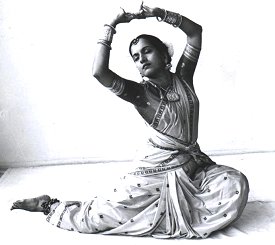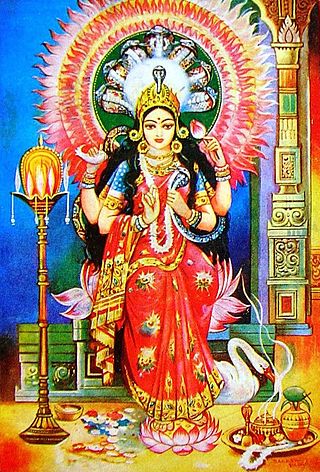The topic of this article may not meet Wikipedia's general notability guideline .(February 2019) |
Kamrupi dance is group of dances originating in ancient Kamrup, [1] forming one of the cultural norm of region. [2]
The topic of this article may not meet Wikipedia's general notability guideline .(February 2019) |
Kamrupi dance is group of dances originating in ancient Kamrup, [1] forming one of the cultural norm of region. [2]
Kamrupi dance originated from Bhaona dance. [3]
Phalguni, Gita, Karnarjuna along with others are variants of Kamrupi dance. [3]

The music of Assam consists various genres of folk and modern music, drawing its artistic basis from the history of Assam, from Assamese culture and its ancient traditions. In recent times, starting from the late eighties, popular artists have modernised the music catering to local popular demand.

Kamarupi Prakrit is the postulated Middle Indo-Aryan (MIA) Prakrit language used in ancient Kamarupa. This language has been derived from Gauda-Kamarupi Prakrit and the historical ancestor of the Kamatapuri lects and the modern Assamese language; and can be dated prior to 1250 CE, when the proto-Kamta language, the parent of the Kamatapuri lects, began to develop. Though not substantially proven, the existence of the language that predated the Kamatapuri lects and modern Assamese is widely believed to be descended from it.

The music of West Bengal includes multiple indigenous musical genres such as Baul, Ramprasadi, Bishnupuri Classical, Kirtan, Shyama Sangeet, Rabindra Sangeet, Nazrul Geeti, Dwijendrageeti, Prabhat Samgiita, Agamani-Vijaya, Patua Sangeet, Gambhira, Bhatiali, Bhawaiya, Bengali Rock.
Goalpariya is a group of Indo-Aryan dialects spoken in the Goalpara region of Assam, India. Along with Kamrupi, they form the western group of Assamese dialects. The North Bengali dialect is situated to its west, amidst a number of Tibeto-Burman speech communities. The basic characteristic of the Goalpariya is that it is a composite one into which words of different concerns and regions have been amalgamated. Deshi people speak this language and there are around 20 lakhs people.

Damayanti Joshi was a noted renowned exponent of the Kathak dance form. She believed Kathak is the art of storytelling. She began in the 1930s dancing in Madame Menaka's troupe, which travelled to many parts of the world. She learnt Kathak from Sitaram Prasad of Jaipur Gharana and became an adept dancer at a very young age, and later trained under from Acchan Maharaj, Lacchu Maharaj and Shambhu Maharaj of Lucknow gharana, thus imbibing nuances from both the traditions. She became independent in the 1950s and achieved prominence in the 1960s, before turning into a guru at her dance school in Mumbai.
Various dance forms are practiced in Tamil Nadu, the southernmost state of India. Tamil Nadu is the home of the Tamil people, who speak Tamil language, one of the oldest surviving languages in India. With archaeological evidence pointing to the Tamilakam region being inhabited for more than 3,800 years, Tamil culture has seen multiple influences over the years and has developed diversely. With its diverse culture, many forms of individual and group dances have their origins in the region.
Pandit Shambhu Maharaj was a Guru of the Lucknow Gharana (school) of the Indian classical dance form, Kathak..Padma Shree Award -1958 Sangeet Natak Academic Award -1967

Silambu, or Gaggara, is an anklet worn and used in a variety of contexts on the Indian subcontinent.

Kamrupi Lokgeet is popular form of folk music that expresses thoughts and emotion of the Kamrupi people. The songs are derived from Ancient Kamrup. The language of Kamrupi lokgeet are different dialects and ancestral forms of Assamese, including Early Assamese, Kamrupi dialects and Standard Assamese.

Gopi Krishna was an Indian Kathak dancer, actor and choreographer. He also studied Bharatnatyam. In 1952, at the age of seventeen, Gopi Krishna became one of the youngest choreographers in Hindi film history when he was hired to choreograph dances.
Kamrupi literature is the literature written in the modern Kamrupi dialects of Assamese language.
Chaygaon is a town in Kamrup district of Assam, India; situated on the south bank of the Brahmaputra river. It is 38 km from major town Guwahati. The town is known for "Maa Chandika Devalaya", a Shakti Peeth, where thousands of devotees visit during Durga Puja. Historical "Mer Ghar" of Chand Sadagar situated in Champak Nagar, Chaygaon.

Kamarupa was a kingdom in Northeast India that was ruled by three dynasties from their capitals in Pragjyotishpura, Haruppeshwara, and Durjaya. The kingdom was known for its power and influence in the region.
Kamrupi dialects are a group of regional dialects of Assamese, spoken in the Kamrup region. It formerly enjoyed prestige status. It is one of two western dialect groups of the Assamese language, the other being Goalpariya. Kamrupi is heterogeneous with three subdialects— Barpetia dialect, Nalbariya dialect and Palasbaria dialect.

Ojapali is a traditional shamanistic type of indigenous folk dance from Assam in the northeastern region of India. Ojapali is believed to have evolved from Kathakata tradition and is performed in a group; it is believed to be one of the oldest art forms of Assam. Originally evolved in the Kamata state the western and northern part of river Brahmaputra later limited to Darrang area under the patronisation of Darrangi King Dharmanarayana. The repertoire of this performance consists of songs, dialogues, gesture, improvised acting and dramatisation etc. The group consists of an Oja, who leads the performance and four or five palies, who supplement the performance with continuously playing cymbal. Among the Palies Daina pali who stand on the right-hand side of the Oja is the active one and he and Oja take the performance forward. Many believe that Shankardev took inspiration from Ojapali to create his Ankiya Bhaona. Moreover, he also created his own Sattriya Ojapali. Generally Darrangi Suknanni Ojapali sings the lyrics written by Sukabi Narayanadeva in Padmapurana. Padma Purana covers the story of serpent goddess Maroi(manasa devi). Ojapali is associated with Shakti Puja, including the deities manasa, kali, durga, kesikhaiti, kakogoshani etc.

Kamrup is the modern region situated between two rivers, the Manas and the Barnadi in Western Assam, with the same territorial extent as the Colonial and post-Colonial "Undivided Kamrup district". It was the capital region of two of the three dynasties of Kamarupa and Guwahati, the current political center of Assam, is situated here. It is characterized by its cultural artifacts.
Kamrupi culture refers to the cultural norms of people of colonial Kamrup district.
Prachin Kamrupi Nritya Sangha is troupe for preservation and promotion of ancient Kamrupi dance forms. Since its formation it helped in renewing interest in forgotten dance forms of region.
The Kamrupi people are a linguistic group that speak the Kamrupi dialects of Assamese and are found in the colonial Kamrup district region of Assam, India.

Buka Bhaona, also known as Pekjatra is a special bhaona held in conjunction with the Nandotsav on the occasion of Krishna Janmashtami. The event is being held at Puronigudam in Nagaon district and Jamugurihat in Sonitpur district respectively. There are also many others in Barpeta, Majuli, Charaideu and other areas.
A new form of dance technique has been evolved from Bhaona which is a sophisticated type of dancing, known as "Kamrupi" dance.
The devadasis who performed this dance, it may be mentioned, were attached to temples of Shiva as well as of Vishnu. The Ojapali dance belongs to the Kamrup district, and it is therefore sometimes spoken of as Kamrupi dance. There are two types of Ojapali, the Sakta and the Vaisnava
Probably this nomenclature was attributed to give a provincial touch to the technique, because it had its birth from Assam. There is a district even now in the State by that name. The famous ""Kamrupi" dances are "Phalguni", "Gita", "Karnarjuna",etc.